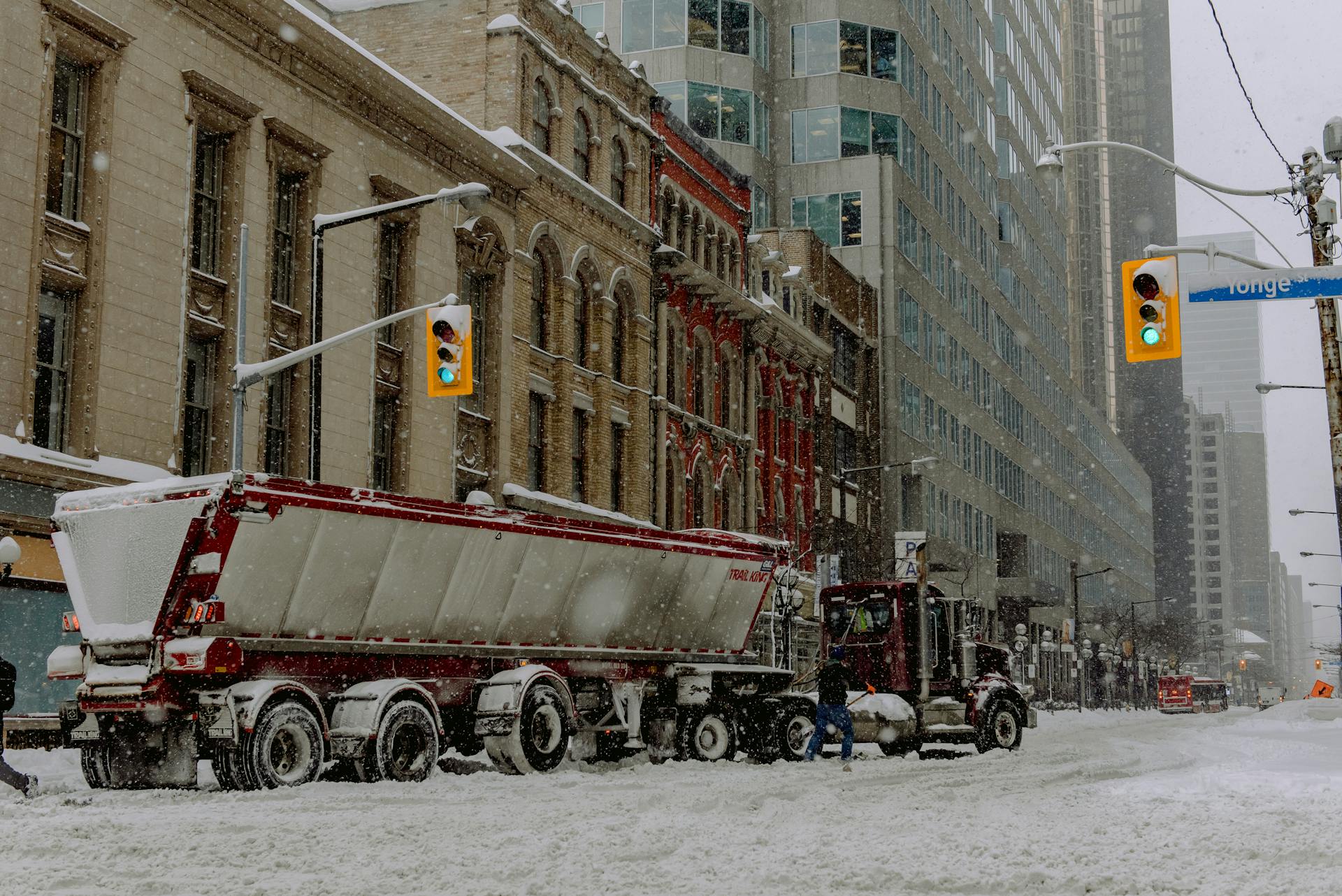
Driving a semi truck in the snow requires a unique set of skills and techniques.
Slowing down is crucial, as stopping distances can be up to 40% longer on snowy roads.
The key to safe winter driving is to maintain a consistent speed and avoid sudden movements.
A good rule of thumb is to leave plenty of space between you and the vehicle in front, at least 8-10 seconds.
In snowy conditions, it's essential to use your low gear when driving uphill to maintain traction and control.
Get Your Truck Ready
Before hitting the road, your semi-truck needs to be winter-ready. A well-prepared truck is your first line of defense against harsh conditions.
Check your heater to ensure it's working properly, so you have time to get necessary repairs if needed. Cold weather can cause serious damage to your vehicle if you're not prepared.
Proper tire pressure, winter-grade tires, or chains are non-negotiable for icy roads. Diesel engines, in particular, need extra care, such as anti-gel additives and block heaters to keep running smoothly.
A CB radio allows you to communicate with fellow truck drivers and learn about road conditions. This can be a lifesaver, especially in areas with limited cell phone reception.
To prepare your truck for winter, focus on the basics, like tires and engine prep. This includes checking coolant levels, disconnecting the battery, and covering the truck when parked for an extended period.
Here are some essential items to pack in your truck for emergency situations:
- Blankets and/or a sleeping bag
- Hand warmers
- Snacks and bottled water
- Flashlight and extra batteries
- Multi-tool and portable phone charger
- Reflective triangles and flares
- First-aid kit
- Snow shovel and traction mats
Remember to check your belts, cooling system, hoses, and tires for signs of wear before every winter trip. This will help prevent breakdowns and keep you safe on the road.
Safety Measures
Slowing down is non-negotiable on icy roads, as speeding can be like playing with fire and lead to accidents.
Lower your speed and increase your following distance to allow for extra reaction time, especially in winter conditions where vehicles are prone to slipping and sliding.

Braking on slippery roads isn't the same as stopping on dry pavement, so always brake as gently as possible to avoid skidding.
One of the most dangerous hazards on the road is black ice, which can appear out of nowhere and is often found on bridges and shaded areas.
To identify black ice, look for roads that look wet but don't emit much spray, and decrease your speed, stay alert, and get ready for slippery road conditions.
Maintaining higher fuel levels is crucial in winter weather, as snowstorms can shut down roads and compromise fuel supply.
Winter storms can also shut down gas stations, so it's essential to fuel up more often to ensure you have enough gas to reach your destination.
Packing spare layers, food, and safety equipment in your truck can save you from stress and discomfort if you get stranded in winter weather.
Having a flashlight, spare batteries, nonperishable food, and plenty of water with you can also be a lifesaver if you need to inspect tires or your trailer in low light or get stranded for an extended period.
Winter Driving Techniques
Driving a semi-truck in the snow requires a different approach than driving on dry pavement. Give yourself plenty of space to brake, as the distance it takes to come to a full stop can be much longer than you'd expect.
Braking on winter roads can be tricky, especially if the roads are slick. If your truck's wheels lock up when you hit the brakes, you'll need even more space to slow down. Always anticipate what could increase your braking distance and plan accordingly.
Use winter tires or chains to provide extra grip on snow-packed roads, especially in hilly or mountainous areas. Winter tires are designed with deeper treads and specialized rubber compounds that stay flexible in freezing temperatures, improving grip.
Driving on snowy roads requires smooth, deliberate movements to maintain control. Avoid sudden braking, sharp turns, or rapid acceleration, as these actions can cause your tires to lose traction and lead to skidding.

Slow down, even if this means driving below the speed limit. Commercial truck drivers should only operate their vehicle as fast as their abilities allow and the capabilities of the vehicle permit.
Be mindful of other drivers on the road, as passenger vehicles and smaller trucks may behave unpredictably in snow. Give them plenty of space, especially around hills, curves, and intersections, where traction is often compromised.
Emergency Planning
Emergency planning is crucial when driving a semi truck in the snow. An emergency kit is your lifeline in unexpected situations, so pack essentials like blankets, hand warmers, snacks, and bottled water to stay comfortable if stranded.
Carry tools like a flashlight, multi-tool, and portable phone charger for minor fixes or calling for help. Reflective triangles, flares, and a first-aid kit ensure you're visible and prepared for emergencies. Keep a snow shovel and traction mats in your truck to dig out of snowbanks or regain traction.
It's also essential to keep your fuel tank at least half full to prevent fuel lines from freezing and ensure you have enough gas to run the heater if needed. This simple precaution can save you from a potentially disastrous situation.
Know When to Shut Off

As a truck driver, you're used to pushing through challenging conditions, but it's essential to know when to pull over and shut off the engine.
Driving in severe weather conditions can be hazardous, and it's crucial to communicate with your trucking company about winter weather policies.
Learning to recognize when it's time to shut off the engine can save you from headaches and potential accidents.
Logistics Management and Fleet Operations experts recommend maintaining vehicle safety and reliability by implementing strategies such as regular maintenance and driver education.
To stay safe, give your truck a once-over before hitting the road, checking for ice and snow on mirrors, windows, and lights.
You should also keep a solid three-point grip when getting in or out of your cab, as icy steps can be a risk.
Here are some key considerations to keep in mind:
By being aware of these risks and taking proactive steps, you can stay safe on the road and reduce the risk of accidents.
Be Ready for Emergencies

Having an emergency kit in your truck is crucial for staying safe on the road. Pack essentials like blankets, hand warmers, snacks, and bottled water to stay comfortable if you're stranded.
A sudden storm or breakdown can happen anytime, so it's essential to be prepared. Carry tools like a flashlight, multi-tool, and portable phone charger for minor fixes or calling for help.
Keep reflective triangles, flares, and a first-aid kit in your truck to ensure you're visible and prepared for emergencies. A snow shovel and traction mats can also be lifesavers if you get stuck in a snowbank.
Always keep your fuel tank at least half full to prevent fuel lines from freezing and ensure you have enough gas to run the heater if needed.
Here are some must-haves to include in your emergency kit:
Blizzard Traps Trucks in South Dakota
A blizzard in South Dakota trapped over 70 semi-trucks under huge snowdrifts for days. The extreme weather conditions made it difficult to move, with some trucks buried up to the top of their sleeper.
Quail, a truck driver, shared his experience of being stuck for several days. He had a buddy bring him a shovel, and another tried to pull him out, but they broke two chains trying to get him to move.
Photos showed snow piled high near the top of Quail's Peterbilt, making it especially tough to yank out. A local with heavy equipment was able to clear the front end so the radiator could breathe.
Farm kids with a 4WD tractor and a big blade on it offered to pull Quail out for $200, but he was able to get assistance from All Pro Towing. They used a mighty wrecker to get him unstuck, after seeing his viral Facebook posts.
It took about an hour to scoop the snow off the load once Quail was pulled out. He was supposed to deliver a refrigeration unit to Marysville, Washington, but the delivery is still in the works due to the blizzard.
Winter Driving Tips for Truckers
Winter driving tips for truckers are crucial to stay safe on icy roads. Slowing down is non-negotiable, as speeding on icy roads is like playing with fire - it's only a matter of time before something goes wrong.
Icy roads pose an even greater risk for semi-trucks, which are heavier and take longer to stop. Black ice often forms on bridges and shaded areas, so approach these spots with extra caution.
To mitigate these hazards, know how to react when you hit ice - gently steer into the slide instead of slamming the brakes. This can save you from losing control.
The chilly temperatures aren't comfortable for either you or your big rig, and snow and ice drastically reduce tire grip on the road. This primarily comes down to traction.
Staying sharp and knowing your truck inside and out is key to making it through another winter season. Always be a step ahead of potential hazards.
A CB radio can be a lifesaver, allowing you to communicate with fellow truck drivers and learn about road conditions.
Winter Driving Challenges
Winter driving challenges are real, and they can be downright scary. Icy roads demand your full attention, and speeding on them is like playing with fire.
Black ice often forms on bridges and shaded areas, so approach these spots with extra caution. It blends in with the road and can catch even experienced drivers off guard.
Slowing down is non-negotiable on icy roads, and knowing how to react when you hit ice can save you from losing control. If your truck starts to slide, gently steer into the slide instead of slamming the brakes.
Snow-covered highways bring their own set of difficulties, and preparing for them requires a different approach. The chilly temperatures aren't comfortable for either you or your big rig.
Tire grip on the road is drastically reduced by snow and ice, making traction a major issue. This is why winter conditions can be treacherous.
Winter conditions can be unpredictable, and it's always worth reminding both rookies and seasoned drivers about the challenges they bring.
Frequently Asked Questions
How fast can you drive a semi with snow chains?
Drive a semi with snow chains at 30 mph or less for safe traction and control
Are heavy duty trucks good in snow?
Lifted trucks can handle deep snow better than stock vehicles, but they're more prone to rolling over due to their higher center of gravity. Be cautious when driving a lifted truck in snowy conditions, especially when cornering.
How do you get a semi-truck out of snow?
To get a semi-truck unstuck from snow, use tire chains or a winch if available, and consider enlisting another vehicle for assistance if necessary. Additional help may be required, so it's best to assess the situation carefully before attempting to free the vehicle.
How to drive a semi on icy roads?
When driving a semi on icy roads, take your foot off the fuel as soon as you hit the ice to maintain control. This simple step can help prevent accidents and keep you safe on slippery roads
Sources
- https://blog.truckerguideapp.com/post/how-to-drive-a-semi-truck-in-winter-5-proven-steps
- https://www.hmdtrucking.com/blog/winter-driving-tips-for-truck-drivers/
- https://www.lrwlawfirm.com/safety-tips-when-driving-a-semi-truck-during-the-winter/
- https://www.linkedin.com/pulse/winter-weather-semi-truck-driving-safety-tips-ice-snow-milosevic
- https://www.thedrive.com/news/massive-snowstorm-buries-70-semis-at-truck-stop-for-nearly-a-week
Featured Images: pexels.com


